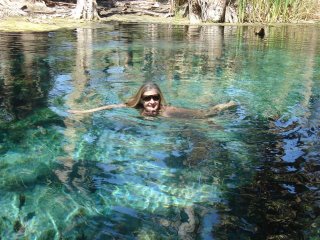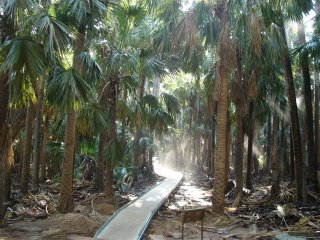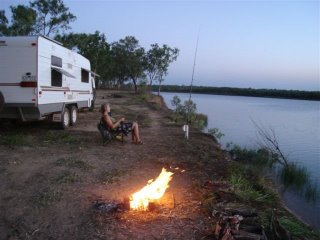We decided we would only “shop up” as we pulled out of Katherine next day and being in such close proximity, chose the hot springs as a perfect location to relax and enjoy the soothing water for the afternoon. While here a month ago we stayed in the same spot chatting. On this visit we gently floated down the stream until it came to a weir, slithered over the crest and found ourselves in a mini-plunge pool of tiny effervescing bubbles before a strong current pushed us on downstream.
Eureka – the books for Lea are finally in her hands! They left England in late March and finally caught up with us in Katherine, six months later, after criss-crossing Australia a good few times. After singing the praises of the internet café we had discovered in Katherine on our first visit, this time round the server had collapsed and we had no alternative but to return to the nightmarish one at the Art Gallery to send off the blog. We hadn’t been able to send our photos from there successfully and it happened again. Frustrated and hot we set off down the Stuart Highway only to encounter a strong headwind slowing our progress along the 100 odd kms we had to travel.
Mataranka, land of the Never-Never – supposedly you reach this country and you never, never want to leave. Jeannie Gunn’s classic We of the Never Never tells the story of her arrival as a young bride to this harsh area and her experiences living on remote Elsey Station. Previously we had come to Mataranka’s thermal pool on a whistle-stop Easter weekend and now look forward to exploring this area. The little town of Mataranka proved worth stopping in. Not only were we able to send the photos easily, George was able to sample one of Kelly’s home made meat pies! We would never dream of going to buy a meat pie from a Mobil service station. Yet that is where we were directed for Kelly’s legendary pie. Since our first visit, Elsey National Park has opened up another section known as Bitter Springs. It was so close to the town it was worth going to peek and have our lunch there. The pie definitely proved good value for money in flavour and content and Bitter Springs was wonderful, so much so we spent the afternoon in the thermal waters. Elsey Station encompassed Bitter Springs and over a 100 years ago Jeannie Gunn described them as “a chain of clear crystal pools with emerald green mossy banks…”. We found the Springs lying within a tract of tropical swamp-forest predominantly made up of tall cabbage palms and paper-bark trees. The hot winds gusting at the time, rattling the palm fronds and sending the odd one crashing down only served to heighten our sense of arrival in this lush oasis. National Parks have left the Springs in a remarkably natural state by limiting the infrastructure to a circular path winding through the forest, a short boardwalk, a viewing platform and a bridge over the stream and, to prevent damage to the banks, have provided two access stairways into the water. On reaching the first stairway our breath was taken away by the clarity of the water; the strange shapes of natural debris on the floor of the channel were artworks in themselves; the greenness of the fringing bulrushes and floating algae; orb spiders in their webs suspended across the channel. With the place to ourselves, although not for long, we slithered into the surprisingly deep tepid waters with a current that wanted to pull us downstream. Blissful is an under-statement.

Bitter Springs
In chatting to a fellow bather he told us of adjacent Mataranka Cabins and its camping ground within easy walking distance of the Springs. We made haste to book in at this place with its un-prepossessing name. It was quite the opposite with wonderful un-powered sites hidden on the edge of the Roper River.
We resisted the temptation to return to the Springs until after dinner. Making our way there that night we walked back through the main camp Lea stopped to use the toilet, moments later calling out to George to come and see a pale little frog ornamentally perched on a wall brace. The caretakers proceeded to show us how each toilet cistern was full of frogs. These little fellows get into the toilet bowl and climb up the flush pipe into the cistern.
We had no need for our torch as we made our way to the Springs, moonlight lit the way, clearly defining and accentuating the shadows on the gravel path. We had entered another world - fireflies flitting about; the sight and sound of flying foxes; the silent water, mirror calm and very inviting. Nature had orchestrated a most memorable night for us.
Reluctant as we were to leave Bitter Springs we were keen to see our original destination – the thermal pools at Mataranka homestead. A sign to the cemetery had us call in there to see the graves of Aeneas Gunn (Jeanie’s husband who died so early into their marriage) and “Fizzer” the mailman from her book. Neither was buried there but, while looking, George pointed out a dead flying fox hanging on the back barbed wire fence. Perplexed by yet another example of a dead bat hanging from a fence we realised it was still alive. On approaching it George found that the bat was hanging from a barb that had penetrated its top lip. In its panic it had ripped holes in its wings. Lea was dispatched to get a towel to enwrap the bat, preventing further damage while George freed it. We left it to clamber up a tree and recover.
Arriving at Mataranka Homestead shortly after, we were confronted by a scene from a Wild West Show with gunshots ringing out in all directions from the swamp forest. Swarms of flying foxes above the canopy, displaced by the uproar, gave us an indication of what was happening. The Park rangers were displacing bats, using gas guns, hoping they would relocate to another roost. No doubt this is another act of futility occurring due to public pressure. Unfortunately for the bats their daily roosts were in huge trees directly above the thermal pool polluting the area with noise and faeces. George remembers a strategy used at the same site five years ago to engulf the roosts with fire in a desperate effort to eradicate them. Rather than adopting a “live and let live” approach they have a never ending problem. Walking down for a swim in the thermal spring mid-afternoon we found a notice at the entrance warning of water sprinklers being used intermittently along the length of the boardwalks to disperse bats. Considering all the harassment and alternative roosting sites within the forest we wonder why the bats chose to stay in such close proximity to the pool.

Sprinklers over boardwalk to disperse flying foxes (bats)
A weir was constructed during World War II below the Mataranka Thermal Springs to create a pool for the recreation of soldiers stationed in the area. Its original R&R function has not changed as many people come here now. As a result a boardwalk leads you through the dense forest, the pool is partly surrounded by stone walls and paving. Nevertheless, it is a picturesque setting and ideally suited to families. We learnt from our first visit that if do not want to swim with the crowds – swim at night. That’s what we did that night and virtually had it to ourselves. With the bats out foraging it was incredibly silent bar the odd crickets.
After our swim we took the trail along the Waterhouse river to Stevie’s Hole. Walking along the dusty red track through eucalypt woodlands with the sun beating down on us; big march flies buzzing around; wallabies and a kangaroo going about their business, sulphur-crested cockatoos breaking cover unexpectedly, sometimes with a squawk sounding as if a cat’s tail had been stood on, making Lea’s heart miss a beat! All epitomising a very Australian storybook scene.
Our intention was to try the Elsey National Park campground at 12 Mile. As we pulled out of the Homestead we couldn’t resist a last swim. Walking down the boardwalk a shot rang out and George, uttering blasphemous explicatives, nearly fell into the swamp! The bats above us didn’t even flinch. They seem to have become habituated to the sound. After a glorious bathe we made our way to the 12 Mile campground only to find it has been closed. We had no option but to head back to “the Track” (Stuart Highway) and continue southwards. We picked up a hitch-hiker at the Roper Bar junction. Ed was better than a radio keeping us entertained all the way to Daly Waters. He spent his first 15 years in Germany collecting broken bones on the ski slopes. Then his family migrated to Australia and here he began collecting snake bites! His worst, from a Taipan, put him in the national snake bite register. Along with his jokes he proved a veritable compendium of information from medical matters to climate statistics, road conditions, places of interest along out forthcoming route, fire management in savannah woodlands, geology and even caught George out by asking if he knew what mecology was! Coined by Dr David Suzuki it apparently means the science of ecosystem restoration???
Leaving Ed on “the Track” we turned of to Daly Waters, the site of Australia’s oldest international airport. Our travel-bible “Camps 3” author recommended site let us down for the first time since leaving Melbourne. The Daly Waters Pub Caravan Park in the heat of the day was not the place we wanted to be. Bill Bryson Down Under felt it was a place only for drinking and got “motherless” here and most only come here to see the classic outback pub.
Not being drinkers we moved on the Hi-Way Inn’s campground on the turn off to Borroloola where we found ourselves a teeny bit of green to camp under. We used our pail of water trick to attract a surprising variety of birds. Full of character and in the majority were Apostle birds delighting us with their antics.
Heading east along the Carpentaria Highway, following the narrow strip road that rose ahead of us into the Gulf Country, we encountered little traffic. With each subtle change in elevation or soil type we would notice corresponding changes in the savannah woodlands. Savannah Way is regarded as Australia’s “adventure drive”, a meandering route from Broome to Cairns linking five World Heritage Areas. It first came to our attention outside Halls Creek and again near Kununurra. While chatting to a fellow traveller after leaving Kakadu he gave us a pamphlet of the Savannah Way route. 200 km down the road we stopped for lunch at Goanna Creek rest area. Well off the road we found ourselves on the crest of a ridge with wooded slopes gently falling away to give us distant perspectives. Beautiful! But we were taken aback by the sight of masses of feathers strewn everywhere, not to mention a bird’s head suspended from a twisted plastic packet in a tree! George immediately went to inspect. His detective work surmised that three unfortunate Australian (Kori) bustards had been turned into bush tucker. Lea was assured there was no smell and in the course of our lunch we decided this was a perfect place to spend the night.

Head of Australian bustard at Goanna Creek
During the afternoon we noticed friar birds, bower birds, butcher birds and honey-eaters trying to get a drink from the water tank in the rest area. George filled the plastic bottle found carved into a suitable bird trough that a thoughtful traveller had wrought. The birds must just wait for someone to arrive because we filled it three times during the afternoon. On sunset a van rattled in with a couple our age from Como in Perth on their way to visit their son in Airlie Beach. To George’s consternation, on spotting the feathers around him the lady sweetly asked whether he’d been hunting for the pot! A full moon throws Lea’s sleep patterns out and this night she had the company of a butcherbird suffering from the same complaint. By 3.00 am he had steadily sung himself into exhaustion. They managed some shut eye before dawn broke.
It was hard to leave “carnage corner” but curiosity got the better of us. Mid morning we set off for King Ash Bay boating and fishing club. A confusing name as it is not on the Gulf. It lies 30km inland amidst the delta of the McArthur River. The club allows non-members to camp along several kms of the McArthur estuary frontage. Pulling in for a late lunch we took the first bit of shade alongside the boat ramp. 4WD’s and boat trailers uniformly parked everywhere. In the very next campsite was Dave the caravan repairer with the barra tattoo on his back! He recognised the buffalo horns on Skiv and came to greet us. Later George did a recce and found a magnificent site well away from the boat ramp and fishers. Perched on a high bank overlooking the main channel we counted ourselves lucky to have such a prime spot, even with firewood and rod holder courtesy of the previous camper. Rising fish soon tempted George to wet his line nicking the fat off our steaks for bait. Excitement reigned when the rod began bending violently. In his dash to get back to rod George nearly fell over the tow hitch …. reeled in what assuredly was a good sized barra, yelling for Lea to take the rod while he climbed down the bank to collect it. Confucius would say “Use trashy bait – you get trashy fish!” Back into the river went the catfish.
Campsite on McArthur estuary (King Ash Bay)
Sunday is a day of rest – we decided to stay put, buy some bait and do serious fishing! Driving around the informal settlement of King Ash Bay to find the mini-mart (a tin shed) we drove out to Batten Point where two major channels of the McArthur delta converge. George walked down to take a photo and Lea was about to follow when, to her horror, a huge wolf-hound hurtled noisily out of a tent hell bent on eating George alive. Reassured by the owner that the dog’s bark was worse than its bite! We nervously noticed that another three pit-bull like dogs were caged in the back of his ute. Glad to return to the safety of Skiv we were intercepted by the owner who had come to enquire about our buffalo horns. He turned out to be a feral pig-hunter. He gave us a vivid account on how the dogs, wearing breastplates, hunt down and catch pigs for him to despatch with a knife. Returning to Getaway with a packet of costly bait sized mullet George began fishing in earnest. With each bite came snapped line. Big fish too large for the line! Our final evening could have been a scene out of On Golden Pond. Instead of loons serenading us as night closed in we had coucals, owls and kookaburras.
No comments:
Post a Comment